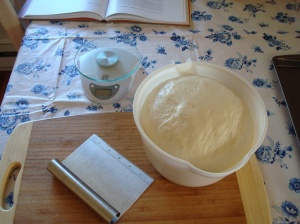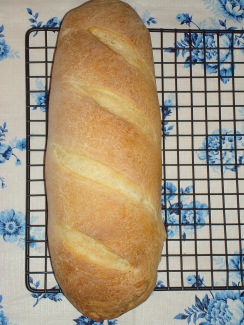I have to say, I had high hopes for these sandwich rolls (they looked so beautiful in the book)—but, unfortunately, mine did not come out quite as expected, which was a tad disappointing. I made the starter the night before and then got up really early the next morning (7:30?) to take it out of the fridge an hour before I started to make the dough. According to the formula, this process would take a while, so I wanted to get an early start in order to avoid being tethered to the house for the entire afternoon. So, starting at around 8:30, I mixed everything (flour, salt, egg, oil, yeast, starter) together in my mixer. One problem I had before even starting the bread was the fact that the formula called for an item that I do not have, and have no idea where I would get it: malt powder…or, barley malt powder, or something to that effect. The book didn’t offer any simple substitute, so I just went on without it. I have no idea how much of an effect it would have had on the finished product, although I am still somewhat curious.


Once it was mixed, I let it rise for two hours. Then, I divided the dough into equal (truly equal, thanks to my scale!) 4 oz pieces, and ended up with seven rolls. Because I don’t have a Kaiser roll cutter, I had to roll out each ball and tie it in a knot to make the appropriate shape. I thought I actually did a pretty fantastic job (I’m not usually very good at forming complex shapes), although they didn’t really keep their beautiful shapes through the baking process.

The rolls had to rest for another hour or so, and then it was time to bake. The instructions said to bake them on a sheet pan lined with baking parchment, and at that point I realized—oh no!—I had none left. Luckily, I was able to instead use my new silicon baking mat that my brother got me for Christmas (and yes, I think that’s the last item that is going to be getting a Christmas shoutout). I have to say, it worked pretty well. Before I put the rolls in the oven, I sprayed them with water (I really should get a spray bottle at this point…the iron just isn’t cutting it anymore) and sprinkled some sesame seeds on top.

They baked at around 400 degrees for about 25-30 minutes. As I said, the knotted parts just kind of melded together, so I didn’t really get any discernible indentations in the rolls. They wound out coming out more like dinner rolls. Also, the minute I took them out of the oven, all of the sesame seeds started falling off. Why does this always happen to me? What am I doing wrong?

Anywho, aside from the small problems I had with these rolls, they tasted pretty good! I’ve been eating them strictly as dinner rolls since, although Michael did make a delicious egg sandwich on one. Next: Lavash crackers. Onward and upward!














